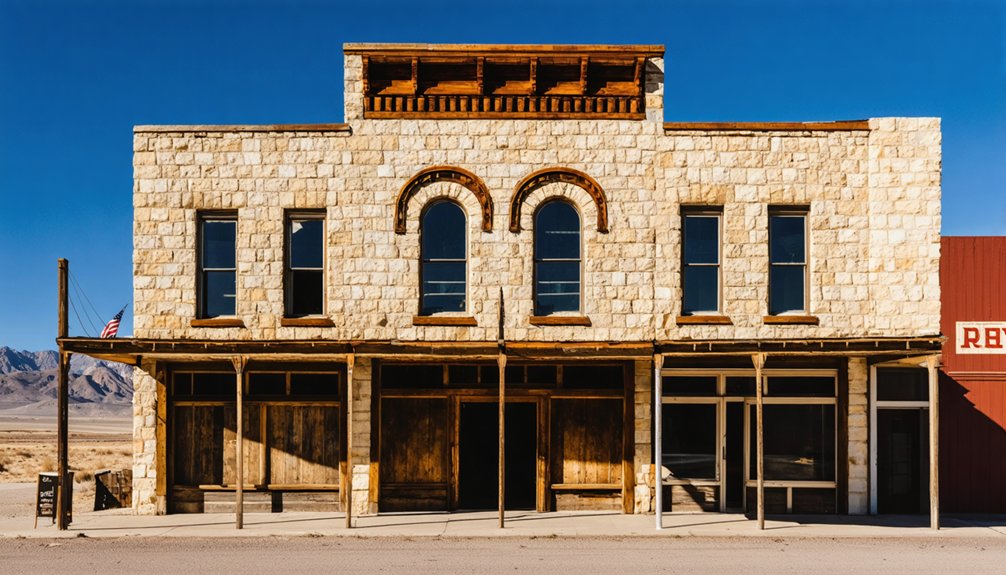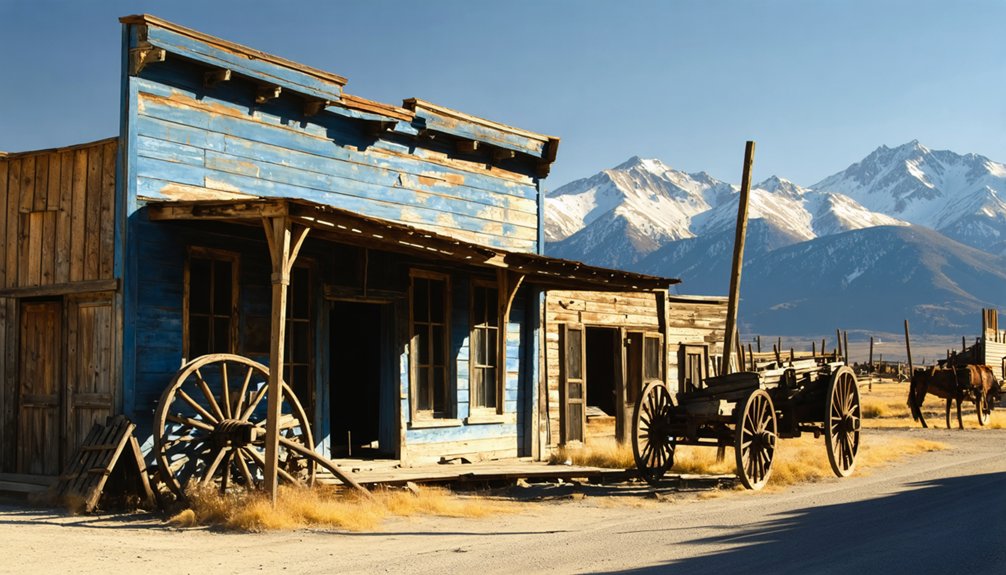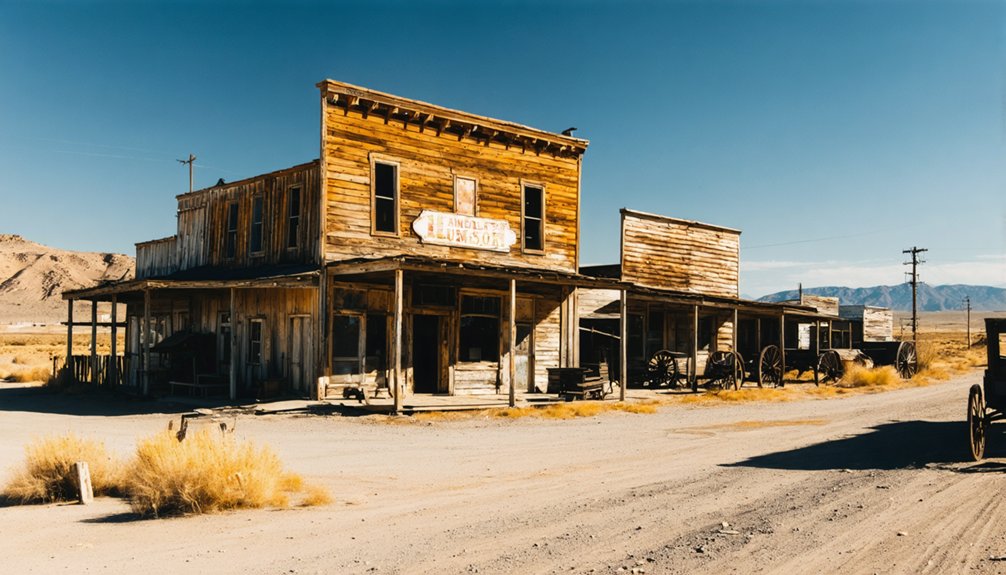You’ll discover America’s best-preserved ghost towns scattered across Western states, each frozen in time from the nation’s mining era. From Bodie’s untouched interiors to Virginia City’s Victorian architecture, these abandoned boomtowns showcase authentic frontier life. Notable sites include Tombstone’s O.K. Corral, St. Elmo’s historic general store, and Calico’s original mining operations. Through preservation efforts, these ten remarkable towns offer direct windows into the Wild West’s golden age, with countless stories waiting to be unearthed.
Key Takeaways
- Bodie, California maintains over 100 original buildings in “arrested decay” with untouched artifacts, offering the most authentic frontier experience.
- Tombstone, Arizona features multiple preserved saloons and historic buildings, famous for the O.K. Corral gunfight site.
- St. Elmo, Colorado contains 43 well-preserved original structures, including historic hotels and a general store still accessible year-round.
- Virginia City, Nevada showcases Victorian architecture from its mining heyday, when the Comstock Lode produced $180 million in metals.
- Deadwood, South Dakota maintains its Wild West heritage through casino-funded restoration projects and daily historical reenactments.
The Ghost Town Time Capsule: Bodie, California
While many ghost towns dot the American West, Bodie, California stands as the most remarkably preserved symbol to the region’s gold rush era. Founded in 1859 after a gold discovery, this once-thriving boomtown peaked with nearly 10,000 residents and 2,000 structures by 1879.
Today, you’ll find over 100 buildings frozen in time through “arrested decay,” where original Bodie artifacts remain exactly as their owners left them. With its notorious reputation, the town earned its infamy through daily street violence and an abundance of vices. What began as W.S. Bodey’s secret prospect transformed into a powerhouse that produced $38 million in precious metals. The establishment of a hydro-electrical center in 1893 showcased the town’s remarkable progress and innovation.
Though ghostly legends and tales of lawlessness surround the town, Bodie’s true legacy lives in its authenticity. As California’s official gold rush ghost town, it offers you an unparalleled glimpse into frontier life, complete with its saloons, schoolhouse, and untouched interiors.
Silver Legacy Lives On: Virginia City, Nevada
Perched at 6,200 feet on Mount Davidson’s eastern slopes, this remarkably preserved town emerged from the legendary Comstock Lode discovery in 1859, triggering the “Rush to Washoe” that transformed Nevada’s destiny.
The discovery of Nevada’s Comstock Lode birthed a silver empire high in the mountains, forever changing the American West.
You’ll walk the same wooden sidewalks where silver barons once strode, their mines yielding an astounding $180 million in precious metals over two decades. A devastating fire in 1870s reshaped the town’s landscape, leading to $10 million in damages and the rebuilding of many iconic structures.
The wealth you’ll discover shaped both the Union’s Civil War effort and San Francisco’s rise as a financial powerhouse.
Today, the town’s Victorian architecture stands frozen in time, while ghost tours guide you through Silver Terrace Cemetery and historic buildings where paranormal activity abounds, making Virginia City an unmatched glimpse into the Wild West’s golden age. Visitors can experience spine-tingling thrills at the Washoe Club Museum, featured on numerous ghost-hunting television shows.
Mountain Mining Marvel: St. Elmo, Colorado
When you visit St. Elmo, Colorado, you’ll discover one of America’s most intact ghost towns, where over 150 patented mining claims once fueled a bustling population of 2,000 residents.
You can explore the remarkably preserved buildings, including the historic general store, hotels, and remnants of the town’s mining infrastructure that earned it a place on the National Register of Historic Places.
Thanks to year-round road maintenance and preservation efforts by the Stark family and local heritage organizations, you’re able to experience this alpine mining marvel in any season, though six buildings were tragically lost to fire in 2002.
The town offers scenic ATV trails through the beautiful backcountry for adventure enthusiasts.
Many visitors still search for quartz and aquamarine in the surrounding mountains, as the region remains rich in these precious minerals.
Historic Buildings Still Standing
Standing as one of America’s best-preserved mining ghost towns, St. Elmo’s historic architecture captures the essence of 1880s Victorian-era design.
Through dedicated preservation efforts, you’ll find approximately 43 original structures that have weathered over a century of harsh mountain conditions.
When you explore St. Elmo today, you’ll discover these remarkable survivors:
- The general merchandise store, still operating seasonally, maintains its authentic frontier character.
- The American House Hotel stands as a symbol of the town’s bustling mining days.
- The Stark family’s distinctive wood-frame buildings showcase period craftsmanship.
- The blacksmith and livery facilities remind visitors of the town’s working heritage.
Despite the devastating 2002 fire that claimed six buildings, St. Elmo’s remaining structures continue to provide an unparalleled glimpse into authentic Western mining life.
Situated at nearly 10,000 feet elevation, the town offers stunning views of the surrounding Sawatch Mountain Range.
At its peak, the town supported over 150 mine claims and a thriving community of prospectors seeking their fortunes in the Colorado mountains.
Mining Legacy Lives On
Through the remarkable success of the Mary Murphy Mine, St. Elmo stands as a symbol of Colorado’s golden age of mining.
The town’s legacy lives on in St. Elmo Society literature, which often references this iconic Western settlement.
You’ll find evidence of the mine’s impressive $60 million gold production throughout the canyon, where state-of-the-art mining technology once extracted ore from deposits exceeding 25 feet in width. The operation’s scale required extensive infrastructure, including a complex system that could process 75 tons of ore daily. Prospectors discovered silver in 1875, launching the region’s mining boom.
What you’re witnessing isn’t just an abandoned mine – it’s the cornerstone of a 150-claim district that employed cutting-edge machinery and supported a thriving community of 2,000 residents.
Even as other mines failed, the Mary Murphy persisted until 1922, when railroad service ended.
Today, you can explore the remnants of this engineering marvel that shaped the American West.
Alpine Ghost Town Access
High in Colorado’s Sawatch Range, St. Elmo stands as a representation of alpine accessibility at 9,961 feet elevation.
You’ll find this remarkably preserved ghost town just 20 miles southwest of Buena Vista, where Chaffee County Road 162 delivers you straight to its historic doorstep. Unlike many remote mountain settlements, St. Elmo offers year-round ghost town exploration thanks to consistent road maintenance.
For the adventurous explorer, St. Elmo delivers four distinct advantages:
- Three-hour drive from Denver on well-maintained roads
- Four-season access with regular plowing
- Direct vehicle access to the town’s historic district
- Proximity to additional attractions like the Mary Murphy Mine and Mt. Antero trailhead
This accessibility has helped preserve St. Elmo’s 43 original structures, making it one of Colorado’s most visitor-friendly mountain ghost towns.
Desert Mercury: Exploring Terlingua, Texas

You’ll encounter one of Texas’s most fascinating ghost towns in Terlingua, where mercury mining once fueled a bustling community of 2,000 residents and today’s preserved ruins tell tales of boom-and-bust frontier life.
The town’s historic structures, including Howard Perry’s mansion and the Chisos Mine company store (now the Terlingua Trading Company), stand as evidence to its mining heritage while serving modern desert adventurers exploring Big Bend National Park.
Beyond its mining past, Terlingua has carved out a new identity through its famous annual chili cook-off tradition, drawing visitors to experience both its rich history and contemporary desert culture.
Mining Heritage Preserved Today
Deep in the heart of Texas’s Big Bend region, the ghost town of Terlingua stands as a remarkable representation of America’s mercury mining heritage.
You’ll discover a mining culture preserved through careful historical preservation efforts, with stone ruins and adobe structures telling stories of the town’s prosperous past.
When exploring Terlingua’s mining heritage today, you’ll find:
- The iconic Perry School from 1930, one of the few intact buildings from the company era
- Original restored homes now serving as residences and galleries
- The historic Terlingua Cemetery, dating back to 1902, commemorating the hardships of mining life
- The Trading Company’s self-guided walking tours that showcase abandoned mineshafts and industrial remnants
Despite environmental hazards from its mercury mining past, Terlingua’s National Register of Historic Places listing guarantees its legacy endures.
Chili Cook-Off Annual Tradition
While Terlingua’s mining heritage draws history enthusiasts year-round, it’s the legendary Chili Cook-Off that transforms this quiet ghost town into a spirited culinary battleground each November.
Since its 1967 inception as a publicity stunt between two rival journalists, these chili traditions have evolved into two major competitions: the Tolbert International and the CASI Championship.
You’ll find hundreds of passionate cooks competing in cast-iron pots, sharing secret recipes passed down through generations. The cook-off culture embodies the free spirit of the American West, where you can experience everything from luxury RV gatherings to rustic tent camping.
Beyond the competition, you’ll discover a vibrant community of “chili heads” who’ve helped elevate this Texas dish into a national phenomenon while supporting charitable causes like ALS research.
Big Bend’s Desert Neighbor
The desert ghost town of Terlingua stands as a tribute to America’s mercury mining legacy, first emerging as a small Mexican village before its transformation into a bustling mining district in the 1880s.
Today, you’ll find a rich tapestry of desert culture woven through the ruins, where mining artifacts tell stories of boom-and-bust cycles that shaped the American West.
As Big Bend National Park‘s fascinating neighbor, Terlingua offers:
- Howard Perry’s 1906 mansion, standing proud among scattered stone ruins
- St. Agnes Church’s weathered remains, evidence of mining-era spirituality
- The historic Terlingua Cemetery, showcasing folk art and cultural fusion
- The Trading Company’s museum, preserving pioneer and mining heritage
You’re free to explore these extensive ruins, where desert solitude meets historical preservation in a uniquely American experience.
Gold Rush Grandeur: Rhyolite, Nevada

Located in Nevada’s Bullfrog Hills, Rhyolite stands as a tribute to America’s explosive gold rush era, sparked by prospectors Frank “Shorty” Harris and Ernest L. Cross in 1904.
After discovering gold-rich quartzite worth $665 per ton, their Bullfrog claim triggered a mining boom that transformed this desert outpost into a thriving metropolis of 10,000 residents.
You’ll find remnants of Rhyolite’s grandeur in its three-story bank building and stone train depot, monuments to an era when the town boasted electricity, railroads, and modern amenities.
The Montgomery Shoshone Mine, once backed by industrialist Charles M. Schwab, produced 690,000 ounces of gold before the crash of 1907.
By 1916, the gold had vanished, and so had the town’s population.
Today, Rhyolite’s well-preserved ruins draw visitors seeking glimpses of the Old West’s fleeting prosperity.
Pioneer Settlement Stories: Bannack, Montana
Standing as Montana’s first territorial capital, Bannack emerged in 1862 when prospectors struck gold along Grasshopper Creek, igniting the state’s inaugural gold rush.
You’ll find pioneer struggles etched into every weathered building, from the creaking floorboards of its historic church to the haunting gallows where vigilante justice once ruled.
The town’s dramatic story unfolds through:
- Sheriff Henry Plummer’s reign of terror leading the “Innocents” gang
- The Vigilance Committee’s swift response, executing 20 outlaws
- A peak population of 10,000 during the gold fever
- Over 60 preserved structures that survived the town’s decline
Today, you can walk Bannack’s authentic boardwalks, preserved meticulously since 1954 as a state park, offering an unvarnished glimpse into the raw reality of frontier life.
Tombstone: The Town Too Tough to Die

Rising from the sun-scorched hills of southeastern Arizona Territory, Tombstone emerged in 1877 after prospector Ed Schieffelin’s silver discovery transformed Goose Flats into one of America’s richest mining boomtowns.
During the silver boom, you’d have found a bustling metropolis of 14,000 residents, complete with over 100 saloons, gambling halls, and an impressive array of amenities including churches, banks, and even an ice cream parlor.
Despite devastating fires in 1881 and 1882, Tombstone’s resilient citizens rebuilt within months using brick and stone.
The town’s frontier lawlessness, epitomized by the legendary Gunfight at the O.K. Corral and the notorious Cowboys’ cattle-rustling operations, cemented its wild reputation.
Today, as a National Historic Landmark, you’ll discover one of Arizona’s best-preserved ghost towns, where the 1870s architecture still stands as proof of the town that proved too tough to die.
Silver City: Idaho’s Mining Heritage
When silver was discovered near War Eagle Mountain in 1864, Silver City quickly emerged as Idaho’s premier mining boomtown, eclipsing nearby Ruby City as the heart of the Owyhee district.
You’ll find one of America’s best-preserved ghost towns here, with about 70 original structures still standing from its glory days.
During its peak years, Silver City’s riches and remarkable development included:
- Over 100 active mines producing more than $60 million in precious metals
- A sophisticated infrastructure with telegraph service by 1874
- Over 60 ore-processing mills using advanced mining techniques
- The historic Idaho Hotel, which still welcomes visitors today
The town’s historic preservation efforts have maintained its authentic Old West character, letting you experience the raw spirit of American frontier mining while exploring its well-preserved streets and surrounding mountain trails.
The Mining Metropolis: Calico, California
A spectacular silver strike in 1881 transformed Calico, California into one of America’s richest mining boomtowns, where more than 500 mines produced $20 million in silver ore during its twelve-year heyday.
At its peak, you’d have found yourself among 3,500 residents in a thriving metropolis complete with schools, hotels, and lawmen keeping order.
Today, you’ll discover one of the West’s best-preserved examples of mining history, thanks to Walter Knott’s meticulous 1950s restoration.
All but five original buildings stand as they did in the 1880s, earning Calico official recognition as California’s Silver Rush Ghost Town.
While exploring this ghost town tourism landmark, you can venture into Maggie’s Mine, photograph the iconic mountain backdrop, and experience authentic Old West architecture while modern amenities like Starbucks blend discreetly into the historic setting.
Wild West Wonderland: Deadwood, South Dakota
Deep in South Dakota’s Black Hills, Deadwood emerged in 1876 as one of America’s most notorious gold rush settlements, where prospectors illegally staked their claims on Lakota territory after Colonel George Armstrong Custer’s expedition discovered gold in 1874.
Unlike many Wild West towns that faded into obscurity, Deadwood’s preserved heritage draws you into an authentic frontier experience.
You’ll discover a town that’s embraced its colorful past through:
- Historic buildings and Federal Plaza restoration projects funded by casino revenue
- Daily historical reenactments of Wild Bill Hickok’s infamous murder
- Mount Moriah Cemetery’s $3 million restoration featuring graves of frontier legends
- The Homestake Mine legacy, which produced $100 million in gold before closing in 2001
Today, you can experience both modern gaming entertainment and carefully preserved 19th-century architecture that brings the Wild West to life.
Frequently Asked Questions
What Safety Precautions Should Visitors Take When Exploring Abandoned Ghost Town Buildings?
You’ll need to assess building stability before entering, wear protective gear, stay alert for wildlife encounters, maintain clear exit paths, and always explore with a partner for safety.
Are Metal Detectors Allowed in These Ghost Towns for Treasure Hunting?
You’ll need explicit permission for metal detecting since most ghost towns prohibit treasure hunting. Check regulations carefully – it’s often illegal on public lands and requires written consent from private owners.
Which Ghost Towns Are Accessible During Winter Months With Heavy Snowfall?
Like snow-capped sentinels, Rhyolite’s desert location offers you year-round access. You’ll need snowmobiles or specialized gear to reach Kennecott, Bannack, and Chesterfield during winter months despite challenging snow conditions.
Do Any Ghost Towns Still Have Active Mining Claims Nearby?
You’ll find active claims near some ghost towns outside protected areas, but most historic mining sites don’t permit operations anymore. The mining history remains preserved while modern claims stay on surrounding lands.
What Paranormal Activities Have Been Reported in These Historic Ghost Towns?
You’ll encounter ghost sightings of miners, outlaws, and townsfolk across these haunted locations, with unexplained sounds, cold spots, mysterious lights, and EVP recordings in abandoned mines, saloons, and jails.
References
- https://www.mentalfloss.com/geography/american-ghost-towns-can-still-walk-through
- https://en.wikipedia.org/wiki/Wikipedia:WikiProject_Ghost_towns
- https://www.christywanders.com/2024/08/top-ghost-towns-for-history-buffs.html
- https://m.dresshead.com/files/scholarship/Documents/Ghost_Towns_Lost_Cities_Of_The_Old_West_Shire_Usa.pdf
- https://backroadplanet.com/10-ghost-towns-in-the-west-that-tell-forgotten-stories/
- https://www.legendsofamerica.com/gt-hiddentales/
- https://www.geotab.com/ghost-towns/
- https://www.youtube.com/watch?v=2sIM72082jc
- https://www.youtube.com/watch?v=yeTVfoQxqJc
- https://cindyknoke.com/2016/08/22/ghost-towns-of-the-wild-west/



